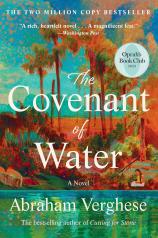The Covenant of Water
Review
The Covenant of Water
THE COVENANT OF WATER, Abraham Verghese’s long-awaited new novel, comprises 10 Parts, 84 chapters, 715 pages, perfect bits of poetry from Raymond Carver and e. e. cummings, and the reminder from Herodotus to “[c]ount no man happy until the end is known.” Among many other things, the story encompasses two continents and three generations of a Malayalis family. The individuals are diverse, troubled and blessed, and each has some connection to The Condition. The puzzle of The Condition, along with the subsequent putting together and taking apart, serves as the thread stitching the book together.
Part One begins in 1900, along the princely states of Cochin and Travancore of South India, with the lengthy journey of 12-year-old Mariamma to meet and marry a handsome widower. Her mother travels with her, but she is an impoverished widow and will return home with few prospects of ever seeing Mariamma again. The groom arrives at last and stands by the girl. When he lifts her veil, he abruptly declares that she is but a child and stomps away. His older sister, Thankamma, chases after him and says it would be best to take the girl into his household until she is ready to be his wife.
"[A]llow yourself to become immersed in the laughter and tears, and discover the unclaimed secrets of this epic, wonderful novel."
He returns to the marriage broker and the ceremony, fastening a thin gold chain around her neck, and they set off for his estate, Parambil. She is introduced to the privileges of being a wealthy landowner’s wife, and she will become Big Ammachi, the matriarch and steadying hand for many years for her family and the people who live at Parambil.
Moving ahead to 1933, Part Two introduces a Scotsman, Digby Kilgour, who leaves Glasgow for Madras as an Assistant Civil Surgeon. He is immediately uncomfortable as he disembarks the ship into the teeming shay of native Indians because he is now identified as an “occupier” and will be moved to the head of any line, given preferential treatment, and served the best food. Only the color of his skin marks him as better than them, and he feels the resentment. There is small comfort knowing that his plan is to make changes. His story will link in surprising ways to Big Ammachi’s family.
In Part Five, 1944, there is sweetness and joy at the betrothal party of Elsie and Philipose, Big Ammachi’s son. Neither the prospective bride nor the groom shows any signs of the shyness usually associated with arranged marriages. They compare their feet and their skin touches. They speak in English so their conversation remains private. They ignore the ammachis who are seated across the room on low cushions. Gathered to supervise, they become apoplectic over these acts of intimacy. They would have blown whistles had they been in possession of them.
Elsie is an extraordinary artist, and Philipose writes newspaper columns about his world, which he calls “Unfictions” and signs An Ordinary Man. As he realizes that Elsie is interested in him, as he is in her, Philipose questions why she has chosen him. She quotes a lede from one of his newspaper columns: “Secrets tend to be hidden in the most obvious places.” He is flattered, and they are wed.
Throughout THE COVENANT OF WATER, central characters take over chapters of their own, showing their everyday lives --- eating fish, splaying rich fleshy mangoes, and sprinkling them with red chili pepper and salt, setting mouths on fire. Big Ammachi talks with God in conversations both polite and demanding. “Lord,” she prays, “I won’t mention specifics. After all, what do you know about my life on earth?” She wants God to know that she was the right wife for her husband and asks where he has been, not watching out for her family as he should.
There is lushness in the south Indian landscape, the swirling waters of 142 rivers, the monsoons that destroy and flood for weeks at a time: “The Madras evening breeze has a body to it, its atomic constituents knitted together to create a thing of substance...” The breeze carries the scents of orchids and salts, and an educated Madrasi will say, “Yes, yes, you are having your Taj Mahal, your Golden Temple, your Eiffel Tower...but can anything match our Madras evening breeze?” No. The Madras evening breeze doesn’t judge caste or privilege, leper or healer, believer or skeptic, landowner or pavement dweller. The breeze seems both part of and representative of the moving feast of sweat, chills, war and peace, famine and plenty.
How do you read this book? After all, it’s a novel so rich, so heavy with wisdom, authentic and fabricated history, and family stories snaking back through the years and heavy wet vines and red soil, between the stocky legs of Damodaran, the elephant who stands guard at Parambil. I became a teacher again. I printed a map of India. I marked pronunciations for cities, foods and names. I jotted down brief summaries of the Parts. I dog-eared the pages with exceptional passages until there were more dog-ears than flats. I read sections aloud to my husband about an extraordinary medical procedure that saved Digby’s hand.
For you? Read THE COVENANT OF WATER as you will. Just allow yourself to become immersed in the laughter and tears, and discover the unclaimed secrets of this epic, wonderful novel.
Reviewed by Jane T. Krebs on May 26, 2023
The Covenant of Water
- Publication Date: May 6, 2025
- Genres: Fiction, Historical Fiction
- Paperback: 768 pages
- Publisher: Grove Press
- ISBN-10: 0802162738
- ISBN-13: 9780802162731




